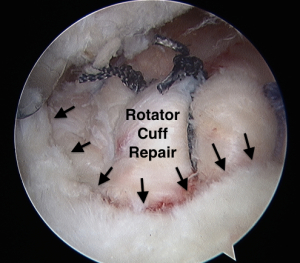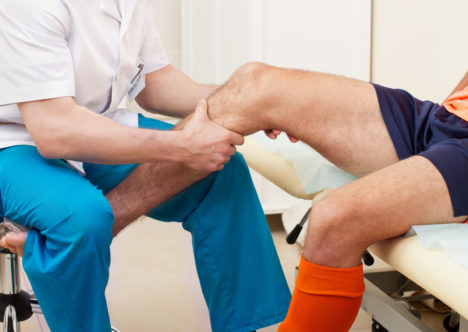Use our convenient online scheduler to book an appointment now.

If you’re young and active and sustain a traumatic rotator cuff tear in your shoulder, or if the injury doesn’t respond to nonsurgical treatment, rotator cuff surgery may be the best solution to alleviate pain and improve mobility.
Which Rotator Cuff Surgery do you need?
Unfortunately, not all rotator cuff tears can be repaired, but there may be other surgical solutions that can help you heal. The appropriate surgical option depends on your age, activity level, symptoms, and goals, as well as the characteristics of the tear itself. The first step in determining the best rotator cuff surgery option is to determine whether the tear is “repairable” or “not repairable” (irreparable).
Repairable Rotator Cuff Tear
To be considered repairable, a torn rotator cuff needs to meet certain criteria, including:
- There is a symptomatic injury, meaning you have pain, limited mobility, etc.
- There is good quality rotator cuff tissue.
- The torn tendon has not significantly pulled away from the insertion point.
- The torn tendon’s muscle has not significantly atrophied.
If your injury meets these criteria, then your rotator cuff tear is likely repairable and surgery would be appropriate.
What are the types of rotator cuff surgery?
There are a number of types of rotator cuff repair surgeries. Some use larger skin incisions, some use smaller skin incisions (“mini-open”), and some are all-arthroscopic.
At Town Center Orthopaedics, most torn rotator cuff surgeries are all-arthroscopic procedures. “Torn rotator cuff surgeries” could also describe rotator cuff (tendon) repairs as well as other procedures described below. This section is only discussing rotator cuff repairs. The benefits of our approach include:
- Better visualization
- More precise surgery
- Less shoulder trauma
- Less postoperative pain
- Better cosmetic appearance
- Improved or similar healing, function, and pain relief to the other techniques.
How is a rotator cuff repair performed?

Although there are subtle differences in surgical techniques for rotator cuff repair, overall, the basic concepts are the same. The procedure is an outpatient one, meaning you go home the same day, and typically includes:
- General Anesthesia +/- Interscalene regional block
- Arthroscopic procedure
- Treatment for symptomatic issues at the same time, determined by the surgeon (labral tears, biceps tendon issues, bursitis, AC joint arthritis, etc.)
- Removal of bursa (bursectomy)
- Elevating acromion (acromioplasty) as needed
- Freeing up torn tendon
- Promoting bleeding at tendon attachment site
- Reattaching all or as much as possible of torn tendon to the humerus using suture anchors
Watch the video below to see an Arthroscopic Rotator Cuff Repair.
After surgery, the arm is placed in a sling and often an ice therapy sleeve. You can learn more about post-op care and recovery here.
Irreparable Rotator Cuff Tear
If your tear cannot be surgically repaired, and nonsurgical treatment has not been effective, your torn rotator cuff surgery options are somewhat limited.
The options are:
- Arthroscopic debridement
- Partial rotator cuff repair
- Superior capsular reconstruction
- Balloon spacer
- Arthroplasty
Arthroscopic Debridement
Even though your torn rotator cuff may not be repairable, sometimes cleaning out the shoulder joint can help alleviate symptoms. During a debridement, causes of painful inflammation–and in some cases, inflamed tissue–is removed and the mobile edges of the torn rotator cuff tissue are smoothed. This procedure can provide considerable symptom relief with minimal trauma and a relatively easy recovery. Even if it doesn’t provide acceptable symptom relief, it doesn’t jeopardize the possibility of any future rotator cuff tear surgery.
Partial Rotator Cuff Repair
When it comes to improving pain and function, some parts of the rotator cuff are more important than others. Additionally, some rotator cuff tears involve multiple tendons. This means that surgery that repairs only a part of the tear or only some of the torn tendons may improve symptoms. This is not always the case, but even so, the final result may be acceptable enough to make this treatment worthwhile.
Superior Capsular Reconstruction
This is a newer arthroscopic procedure that attaches donated and processed cadaveric skin over the humeral head, spanning from the glenoid to the humerus. This protects the humeral head and keeps it positioned on the glenoid during shoulder motion. Both of these functions have been shown to relieve pain and improve function in many patients. The operative procedure as well as the postoperative course and rehab are similar to those of standard arthroscopic rotator cuff tear surgery.
View the short video below to see an animation showing a Superior Capsular Reconstruction procedure.
Arthroplasty
Reverse Total Shoulder Replacement
When all else has failed and your rotator cuff tear is still unacceptably symptomatic, replacing the joint may be the only remaining rotator cuff tear surgery option available. Depending on your age and function, and the presence, degree, and type of shoulder deformity, the type of arthroplasty recommended may vary.
There are two main types of shoulder replacement: partial replacement (hemiarthroplasty) and a particular type of a total shoulder replacement (reverse shoulder arthroplasty).
Determining the best rotator cuff tear surgery for you requires an examination of your shoulder, review of any available imaging studies (X-rays, MRIs, and/or arthroscopy pictures from any prior surgery), and a discussion with your surgeon about your symptoms and goals.
If you have a rotator cuff tear, it is often easier to treat if you get treatment earlier rather than later. So don’t hesitate. See your sports medicine shoulder specialist soon.
AUTHOR
Jeffrey H. Berg, M.D.
Join our Mailing List
TCO provides patients with orthopedic problems the trusted resources and patient-centered advice they need to “Feel Better. Move Better. Be Better.”
© 2024 Town Center Orthopaedics | All Rights Reserved



